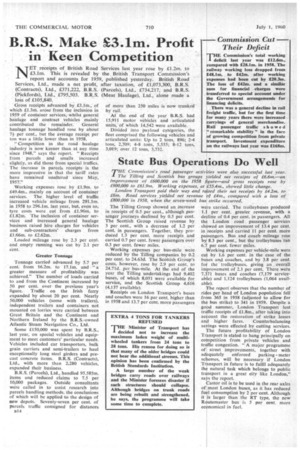State Bus Operations Do Well
Page 48

If you've noticed an error in this article please click here to report it so we can fix it.
THE Commission's road passenger activities were also successful last year.
The Tilling and Scottish bus groups yielded net receipts of £6.6m.—an improvement of £600,000 on the 1958 figure—and gross receipts rose by £904,000 to £61.9m. Working expenses, at £55.4m., showed little change. London Transport paid their way and raised their net receipts by £4.2m. to " £6m. Road services yielded net revenue of £4m., compared with a loss of £800,000 in 1958, when the seven-week bus strike occurred.
The Tilling Group showed an increase in receipts of 0.5 per cent., although passenger journeys declined by 0.5 per cent. The Scottish Group raised revenue by 3 per cent., with a decrease of 1.2 per cent, in passengers. Together, they produced 1.3 per cent. more receipts and carried 0.7 per cent. fewer passengers over 0.3 per cent, fewer miles.
Working expenses per bus-mile were reduced by the Tilling companies by 0.2 per cent. to 24.63d. The Scottish Group's costs. however, rose by 2.9 per cent. to 24.71d. per bus-mile. At the end of the year the Tilling undertakings had 9,402 buses, of which 8,051 were available for service, and the Scottish Group 4,616 (4,137 available).
Receipts on London Transport's buses and coaches were 16 per cent, higher than in 1958 and 13.7 per cent. more passengers were carried. The trolleybuses produced 1.1 per cent, greater revenue, with a decline of 0.4 per cent, in passengers. All the London road . passenger services showed an improvement of 13.4 per cent. in receipts and carried 11 per cent. more passengers. Bus and coach mileage rose by 8.3 per cent., but the trolleybuses ran 6.7 per cent, fewer miles.
Working expenses per vehicle-mile were cut by 1.6 per cent. in the case of the buses and coaches, and by 3.8 per cent. for the trolleybuses, giving an overall improvement of 2.1 per cent. There were 7,371 buses and coaches (7,179 serviceable) and 1,124 trolleybuses (1,064 available).
The report observes that the number of rides per head of London population fell from 365 in 1958 (adjusted to allow for the bus strike) to 341 in 1959. Despite a good summer, London Transport lost traffic receipts of £1.8m., after taking into account the restoration of strike losses and higher fares. Counterbalancing savings were effected by cutting services.
The future profitability of London Transport is stated to hang principally on competition from private vehicles and traffic congestion. "A major programme of street improvements, together with adequately enforced parking meter schemes, will be necessary if London Transport in future is to fulfil adequately the natural task which belongs to public transport in a great city like London," says the report.
Castor oil is to be used in the rear axles of most London buses, as it has reduced fuel consumption by 2 per cent. Although it is larger than the RT type, the new Routemaster bus is $ per cent, more economical in fuel.




























































































































































